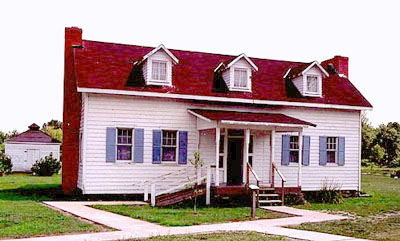George Summers House

Historically, the Summers family was prominent in West Virginia politics. George Summers had an illustrious public career. He was elected to the Virginia Legislature in 1830 and to Congress in 1841. Family tradition states that Lincoln asked him to be his running mate when he ran for his second term as President. Because of his wife's illness, George Summers declined.
The Summers Log house, part of a farmstead along the Kanawha River near Winfield, West Virginia, is a multi-part structure with architectural evidence indicating a construction date during the first quarter of the 19th century. The physical evidence is consistent with oral history, which gives the building's date as 1812.
The house was moved to the Farm Museum from its original site on a farm known as Walnut Grove near Winfield in Putnam County. The farm was first secured by the family of Judge George William Summers, a prominent Kanawha County resident who was widely known in Virginia, West Virginia and national political arenas. Not only was he the first prosecuting attorney of Putnam County, he was also a member of the General Assembly of Virginia and also served two terms in the House of Representatives in the United States Congress. He was a strong pro-Union man. Of interest here is the fact that President Lincoln asked Judge Summers to be his running mate when Lincoln ran for president for a second term. According to family tradition, Summers rejected the offer due to his wife's (Amacetta Laidley Summers) illness.
According to Walden Roush, who with his wife Louise, was the guiding genius in the establishment of the Farm Museum, the Summers house was moved to the Museum on November 23, 1980. Appalachian Power Company, in the process of building the John Amos Power plant, had purchased the farm property of Walnut Grove.
Fred Summers was reputed to be the last family member to occupy the house. It had become the property of his niece, Miss Lucy Quarrier. Through the generosity and interest of Miss Quarrier, the Summers log house was offered to the Museum. Well known in the Art world, Lucy is said to have been one of the founders of the Arts and Crafts Fair at Cedar Lakes near Ripley.
The Log House is a multi-part structure that utilizes two important types of construction in the form of log and plank modules, both of which require expert workmanship. In the original construction, logs were used in the section on the right side of the main entrance while planks were used in the left section. Roush explained that these planks had deteriorated. So it was necessary to use logs also in the left section during the restoration. Planks, however, were used in the back section off the kitchen and dining room.
A large entrance hallway between the two sections included a stairway to the second floor of the one-and-a-half story house. However, the stairway faces the rear of the house so that it would not take up so much room. Two windows are on each front section with three gable-roofed dormer windows extending from the slope of the roof.
Roush stated that it was problematic during the restoration to find weather boarding to match the original. He credited Leon Thompson of the Carolina Lumber Company for finding this material for the Museum. Fireplaces were built in all the rooms, including the upstairs bedrooms. The original mantels were moved with the structure.
Numerous interesting articles of furniture may be seen throughout the house. In the left front room stands an ancient baby crib, mounted on rockers and having a high framework for a canopy used to cover the crib. It was donated to the Museum by John Musgrave.
Also in this room are two other articles of interest. One is what appears to be a High Board but in reality contains a folding bed. Standing in this room is an easel supporting a Shadow Box. This glassed-in box contains a flat surface on which a colorful arrangement of handmade flowers are placed.
Another item that will attract attention is in the kitchen adjoining this room. It is an ancient Home Comfort kitchen range. It was donated by John Scott of Athens, WV. There is another unusual item near the doorway, but we will leave it to the tour guide to explain that one.
The Log House was to have been moved to Charleston, WV, where a full city block had been set aside for it. It was felt that the house would possibly be credited by the National Register of Historic places. This did not develop, and the Farm Museum is the richer for it.
| The
Museum | Animals | Festivals | Plan
a Visit | Map |
| What's New | Staff
| Volunteers | Make a Difference | Contact
Us | What's That? | Home
|